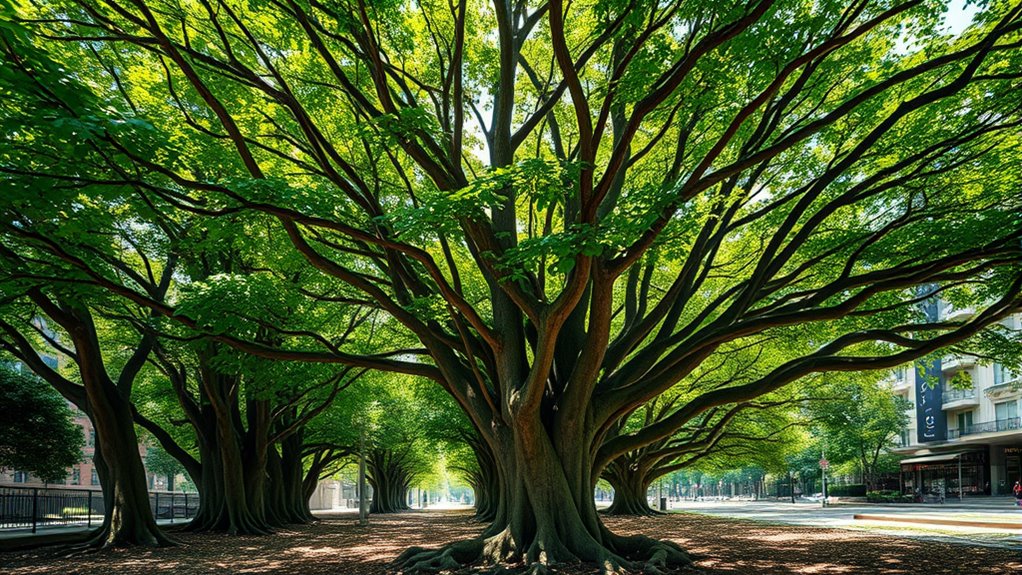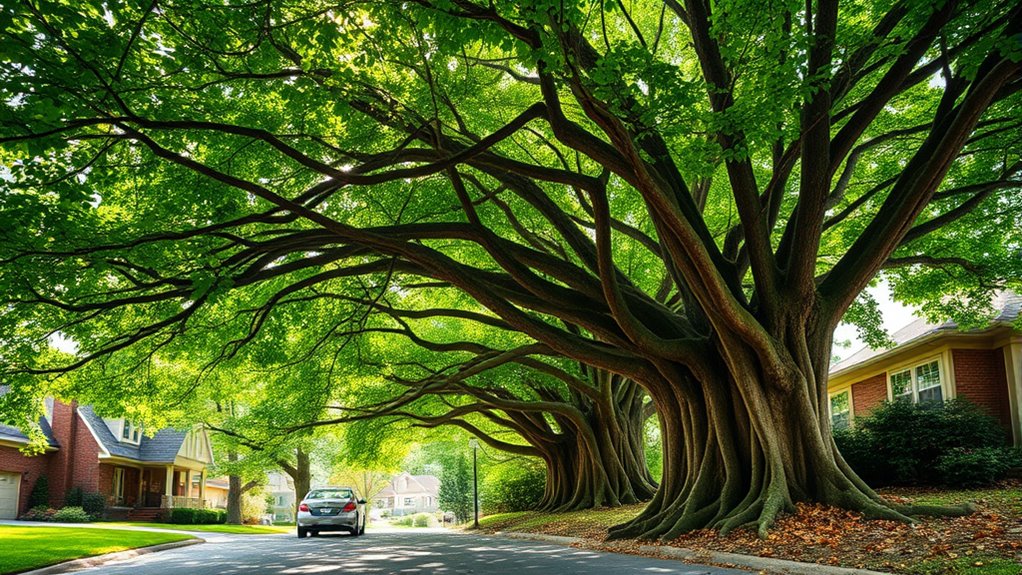Encroaching trees can cause issues like heavy leaf loads, root intrusion, and structural damage if you don’t manage them properly. Regularly inspect and clear gutters to prevent clogging from fallen leaves, and consider installing gutter guards for year-round protection. To address root problems, plant trees at safe distances and add root barriers. Implementing these long-term strategies helps keep your property safe and promotes healthy tree growth—keep exploring to find more effective solutions.
Key Takeaways
- Regularly inspect and clean gutters to manage leaf load and prevent blockages.
- Plant trees at safe distances and install root barriers to minimize root intrusion.
- Prune trees regularly to reduce branch overgrowth and associated debris.
- Conduct professional assessments for early detection of root and structural issues.
- Implement long-term management strategies like species diversification and targeted pruning for safety.
Understanding Tree Growth and Its Impact on Surroundings

Trees grow steadily over time, and their expansion can substantially affect nearby structures, landscapes, and ecosystems. As your trees mature, their branches and roots extend outward, often beyond what you initially expect. Growth rates vary depending on species, soil quality, and environmental conditions, but all trees gradually increase in size. This expansion can lead to interference with buildings, sidewalks, and underground utilities if left unchecked. Roots, in particular, spread wide and deep, searching for water and nutrients, which can cause damage to foundations, pipes, and underground cables. Understanding how trees grow helps you anticipate potential issues and plan accordingly. Recognizing the natural growth patterns allows you to monitor and manage trees proactively, minimizing long-term risks while maintaining the health of your landscape. Additionally, tree tuning techniques such as pruning and root barriers can help control growth and reduce the likelihood of damage over time.
Common Problems Caused by Encroaching Trees

When branches and roots extend beyond their natural boundaries, they can cause a range of problems for property owners. Overgrown trees can damage structures, clog drainage systems, and create safety hazards. Roots may crack foundations, pavements, or underground utilities, leading to costly repairs. Falling branches threaten people, pets, and property during storms or high winds. Additionally, encroaching trees can block sunlight, affecting gardens and lawns. You might also face increased maintenance costs from fallen leaves, twigs, and debris. If trees are too close, they can interfere with power lines, causing outages or fire risks. Managing this encroachment early helps prevent these issues and preserves your property’s safety and value. Recognizing these problems allows you to take proactive steps to address them effectively. Proper tree maintenance can help minimize long-term damage and ensure safety around your property.
Evaluating and Managing Leaf Load Accumulation

Regularly evaluating leaf load accumulation is essential to prevent clogged gutters and drainage issues. You should inspect your roof and gutters at least twice a season, especially during peak leaf fall. Use a sturdy ladder and wear gloves for safety. To manage leaf buildup effectively, consider the following options:
| Method | Frequency | Tools Needed |
|---|---|---|
| Manual removal | Monthly during fall | Leaf rakes, gloves |
| Gutter guards | Year-round | Installation tools |
| Professional cleaning | Annually | Contractor services |
Additionally, selecting preppy dog names can add a touch of sophistication to your pet’s identity, reflecting a refined personality that complements your overall style.
Root Intrusion: Causes, Risks, and Prevention Strategies

Overgrown roots can cause significant damage to your property if left unchecked, often infiltrating underground utilities, foundation walls, and drainage systems. Roots seek moisture and nutrients, making them prone to invading spaces where they shouldn’t be. Preventing intrusion involves understanding the causes, such as planting trees too close to structures or neglecting root barriers. Risks include costly repairs, compromised foundation stability, and blocked drainage. To minimize these dangers, consider strategic planting distances, install root barriers early, and regularly inspect your landscape for signs of root growth near structures. Staying vigilant helps protect your property from root-related damage. Additionally, understanding the Law of Attraction can aid in maintaining a positive mindset towards proactive landscape management.
Long‑Term Approaches to Balancing Tree Health and Structural Safety

Achieving a balance between maintaining healthy trees and ensuring your property’s safety requires a proactive, long-term management plan. Regular inspections help identify potential issues early, allowing you to address structural concerns before they become serious. Pruning should be performed thoughtfully to remove dead or hazardous branches while preserving the tree’s health. Installing root barriers can limit root intrusion and protect infrastructure over time. Consider consulting arborists for tailored solutions, such as cabling or bracing, which support weak branches or trunks. Diversifying your landscape with a variety of species reduces risk and ensures resilience. Maintaining proper watering, mulching, and fertilization promotes overall tree health. Additionally, understanding long-term sustainability strategies can help maintain a balanced ecosystem that supports both tree vitality and structural safety. By implementing these strategies consistently, you create a sustainable environment where trees thrive without compromising safety.
Frequently Asked Questions
How Can I Identify if a Tree’s Roots Threaten My Property?
You can identify if a tree’s roots threaten your property by observing cracking or unevenness in your foundation, driveways, or sidewalks. Look for roots near the surface, especially during windy days when they may be visible. You might also notice changes in your yard, like gophers or raised soil patches. If you’re unsure, consider consulting an arborist who can assess root growth and recommend appropriate action.
What Are Eco-Friendly Alternatives to Tree Removal?
You can opt for eco-friendly alternatives like pruning branches to reduce root pressure, installing root barriers to redirect roots away from your property, or transplanting the tree if feasible. These methods minimize environmental impact while addressing your concerns. Consulting an arborist ensures you choose the best approach, preserving the tree’s health and benefiting the ecosystem, all without resorting to removal. These solutions are sustainable and considerate of nature.
How Does Climate Change Influence Tree Growth and Encroachment?
Climate change accelerates tree growth, with studies showing some species grow up to 50% faster due to increased CO2 levels. This rapid growth can lead to more aggressive encroachment on nearby structures and land. You might notice trees expanding beyond their usual boundaries, making management harder. To adapt, consider planting native species that naturally regulate growth, helping you balance ecological benefits with the need to prevent problematic encroachment.
Are There Legal Restrictions on Pruning or Removing Encroaching Trees?
Yes, there are legal restrictions on pruning or removing encroaching trees. You need to check local ordinances, which often require permits or adherence to specific guidelines. Some areas protect certain tree species or limit removal during nesting seasons. Before acting, consult your city or county regulations, or speak with a professional arborist. Ignoring these rules can lead to fines or legal disputes, so always verify you’re compliant.
What Are Innovative Technologies for Monitoring Tree Health Long-Term?
You might think monitoring tree health is old-fashioned, but innovative tech proves otherwise. Sensors embedded in the ground or attached to branches track moisture, nutrients, and growth patterns in real-time. Drones equipped with multispectral cameras scan large areas for signs of disease or stress. This tech allows you to catch issues early, saving money and trees long-term, proving that even nature benefits from high-tech oversight.
Conclusion
Remember, a tree’s growth can be both a blessing and a challenge. By understanding how roots and leaves affect your property, you can take proactive steps to manage them. Regular maintenance and thoughtful planning are key to balancing tree health with structural safety. As the saying goes, “An ounce of prevention is worth a pound of cure,” so stay vigilant and address issues early to enjoy the beauty and benefits trees bring without the long-term risks.









